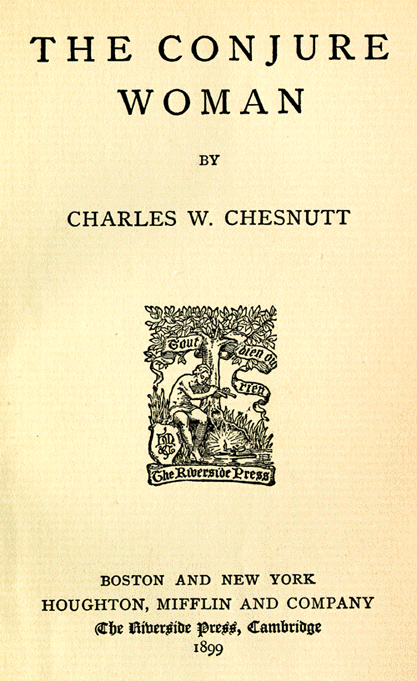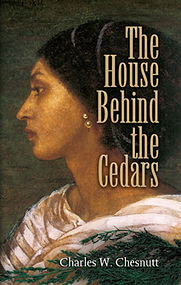Charles Chesnutt
Timeline
Life Events
1858 - Charles W. Chesnutt was born in Cleveland, Ohio on June 20, 1858. In his spare time, he loved reading and writing.
1866 - The family returned to their hometown of Fayetteville, North Carolina to take care of Chesnutt’s grandfather (Hyman).
He was the oldest child in his family and that put a lot of responsibility on him. He helped with the family grocery store and went to school (Andrews). He also helped care for his ailing mother and his siblings ("Charles W. Chesnutt") .
1871 - Charles Chesnutt's mother died (Hyman).
By 1880, worked his way up to the position of Principal for the Fayetteville Normal School for Negroes (“Charles W. Chesnutt”).

(Charles Chesnutt at 16 years old.)
Early Life
Family Life
In 1878, Chesnutt married Susan Perry who was a fellow teacher (Hyman).
In 1883, he and his family moved to Cleveland, Ohio where he passed the state bar exam and started his own court reporting business (Andrews).
By 1898, the couple had three daughters, Helen, Ethel and Dorothy, and one son, Edwin. His daughter, Helen Chesnutt, later published a biography of her father ("Charles W. Chesnutt"). All four of his children were college graduates, his son graduated from Harvard (Hyman).

(Charles Chesnutt, 25.)
Special Honors and Remembrance
1928 - Chesnutt received the Springarn medal from the National Association for the Advancement of Colored People "for his pioneering literary work on behalf of the Afro-American struggle." (Hyman). Chesnutt
1932 - He died at the age of 74 on November 15, 1932 in Cleveland Ohio (Hyman). "Today Chesnutt is recognized as a major innovator in the tradition of Afro American fiction, an important contributor to the deromanticizing trend in post-Civil War southern literature and a singular voice among turn-of-the-century realists who treated the color line in American life (Andrews)."

(NAACP logo)
Literary Events
Articles Published
1887 - Atlantic Monthly published his story called “The Goopered Grapevine” (“Charles W. Chesnutt”). The Atlantic Monthly published six more of Chesnutt’s stories (Hyman). It is important to note that the Atlantic Monthly had never published stories by African American writers before this (“Charles W. Chesnutt”) . This was a tremendous need at this time to bridge a gap between white people and African Americans. Charles Chesnutt was made for this task. He did a fine job because the Atlantic Monthly went on to publish six more of his stories (Hyman).

("The Goophered Grapevine" book cover.)
Novels Published
In 1899, he had a contract with Houghton Mifflin to publish his first book which was a collection of his short stories called, The Conjure Woman (“Charles W. Chesnutt”). On the website called "Documenting the American South" a summary of "The Conjure Woman by Charles Chesnutt says this about the works, "These seven short stories use a frame narrator, John, a white carpetbagger who has moved south to protect his wife Annie's failing health and to begin cultivating a grape vineyard. Enamored by remnants of the plantation world, John portrays the South in largely idealistic terms. Yet Uncle Julius McAdoo, the ex-slave and "trickster" figure extraordinaire who narrates the internal storylines, presents a remarkably different view of southern life. These conjure tales reveal moments of active black resistance to white oppression in addition to calculated (and even self-motivated) plots of revenge (Kirkpatrick, Conjure Woman)."
1899, his second book, The Wife of His Youth and Other Stories of the Color Line was published (“Charles W. Chesnutt”). It is a collection of nine short stories dealing with topics such as the social and psychological effects of Jim Crow laws, African Americans with mixed race ancestry, and intense prejudices against darkly shaded African Americans (Kirkpatrick, The Wife of His Youth).
1900, his first full length novel, The House Behind the Cedars was published (Hyman). This book is about a mixed race brother and sister who are living in a new city and passing for white. Rena, the woman in the story falls in love with a white aristocrat and her secret identity lead conflict ("The House Behind the Cedars (book)").
1905 - Published his last work called, The Colonel’s Dream (Hyman).


("The ConjureWoman" book cover.)
("The Wife of His Youth" book cover.)

("The House Behind the Cedars" book cover.)
Recognition
2008 - Charles Chesnutt is remembered for his achievements as an African American writer and was put on a United States Commemorative stamp (Ziegler). This recognition comes over 80 years after his death. It demonstrates the personal impact Chesnutt made and is still making. He was an African American pioneer when it came to his writing style. He was able to use his writing to reach a white audience and give African Americans a voice through the stories he told.
